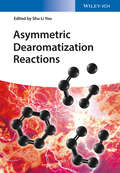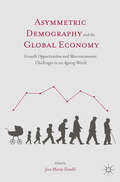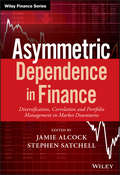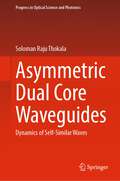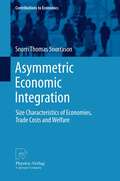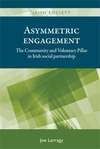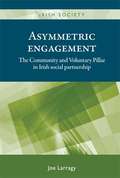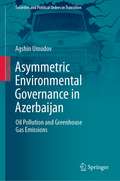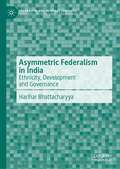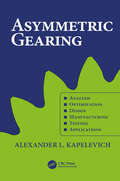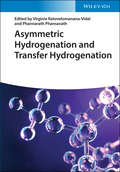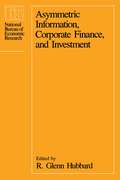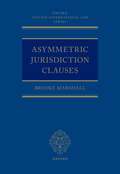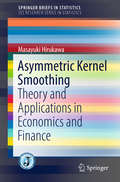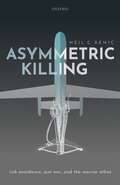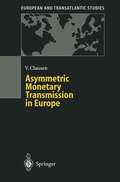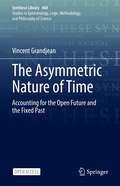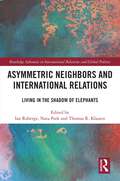- Table View
- List View
Asymmetric Dearomatization Reactions
by Shu-Li YouThe first comprehensive account of the rapidly growing field of asymmetric dearomatization reactions with a focus on catalytic methods. It introduces the concept of dearomatization and describes recent progress in asymmetric reaction procedures with different catalyst systems, such as organocatalysts, transition metal catalysts, and enzymes. Chapters on dearomatizations of electron-deficient aromatic rings, dearomatization reactions via transition metal-catalyzed cross-couplings as well as dearomatization strategies in the synthesis of complex natural products are also included. Written by pioneers in the field, this is a highly valuable source of information not only for professional synthetic chemists in academia and industry but also for all those are interested in asymmetric methodologies and organic synthesis in general.
Asymmetric Demography and the Global Economy: Growth Opportunities and Macroeconomic Challenges in an Ageing World
by José María FanelliThe global demographic transition presents marked asymmetries as poor, emerging, and advanced countries are undergoing different stages of transition. Emerging countries are demographically younger than advanced economies. This youth is favorable to growth and generates a demographic dividend. However, the future of emerging economies will bring a decline in the working-age share and a rise in the older population, as is the case in today's developed world. Hence, developing countries must get rich before getting old, while advanced economies must try not to become poorer as they age. Asymmetric Demography and the Global Economy contributes to our understanding of why this demographic transition matters to the domestic macroeconomics and global capital movements affect the asset accumulation, growth potential, current account, and the economy's international investment position. This collaborative collection approaches these questions from the perspective of "systemically important" emerging countries i.e., members of the G20 but considers both the national and the global sides of the problem.
Asymmetric Dependence in Finance: Diversification, Correlation and Portfolio Management in Market Downturns (Wiley Finance)
by Jamie Alcock Stephen SatchellAvoid downturn vulnerability by managing correlation dependency Asymmetric Dependence in Finance examines the risks and benefits of asset correlation, and provides effective strategies for more profitable portfolio management. Beginning with a thorough explanation of the extent and nature of asymmetric dependence in the financial markets, this book delves into the practical measures fund managers and investors can implement to boost fund performance. From managing asymmetric dependence using Copulas, to mitigating asymmetric dependence risk in real estate, credit and CTA markets, the discussion presents a coherent survey of the state-of-the-art tools available for measuring and managing this difficult but critical issue. Many funds suffered significant losses during recent downturns, despite having a seemingly well-diversified portfolio. Empirical evidence shows that the relation between assets is much richer than previously thought, and correlation between returns is dependent on the state of the market; this book explains this asymmetric dependence and provides authoritative guidance on mitigating the risks. Examine an options-based approach to limiting your portfolio's downside risk Manage asymmetric dependence in larger portfolios and alternate asset classes Get up to speed on alternative portfolio performance management methods Improve fund performance by applying appropriate models and quantitative techniques Correlations between assets increase markedly during market downturns, leading to diversification failure at the very moment it is needed most. The 2008 Global Financial Crisis and the 2006 hedge-fund crisis provide vivid examples, and many investors still bear the scars of heavy losses from their well-managed, well-diversified portfolios. Asymmetric Dependence in Finance shows you what went wrong, and how it can be corrected and managed before the next big threat using the latest methods and models from leading research in quantitative finance.
Asymmetric Dependence in Finance: Diversification, Correlation and Portfolio Management in Market Downturns (Wiley Finance)
by Jamie Alcock Stephen SatchellAvoid downturn vulnerability by managing correlation dependency Asymmetric Dependence in Finance examines the risks and benefits of asset correlation, and provides effective strategies for more profitable portfolio management. Beginning with a thorough explanation of the extent and nature of asymmetric dependence in the financial markets, this book delves into the practical measures fund managers and investors can implement to boost fund performance. From managing asymmetric dependence using Copulas, to mitigating asymmetric dependence risk in real estate, credit and CTA markets, the discussion presents a coherent survey of the state-of-the-art tools available for measuring and managing this difficult but critical issue. Many funds suffered significant losses during recent downturns, despite having a seemingly well-diversified portfolio. Empirical evidence shows that the relation between assets is much richer than previously thought, and correlation between returns is dependent on the state of the market; this book explains this asymmetric dependence and provides authoritative guidance on mitigating the risks. Examine an options-based approach to limiting your portfolio's downside risk Manage asymmetric dependence in larger portfolios and alternate asset classes Get up to speed on alternative portfolio performance management methods Improve fund performance by applying appropriate models and quantitative techniques Correlations between assets increase markedly during market downturns, leading to diversification failure at the very moment it is needed most. The 2008 Global Financial Crisis and the 2006 hedge-fund crisis provide vivid examples, and many investors still bear the scars of heavy losses from their well-managed, well-diversified portfolios. Asymmetric Dependence in Finance shows you what went wrong, and how it can be corrected and managed before the next big threat using the latest methods and models from leading research in quantitative finance.
Asymmetric Dual Core Waveguides: Dynamics of Self-Similar Waves (Progress in Optical Science and Photonics #22)
by Soloman Raju ThokalaThis book highlights the dynamical behavior of self-similar waves in asymmetric dual-core waveguides. The proposed dual-core waveguide consists of two closely spaced adjoining fibers in which one fiber is active and the other is passive. Due to the linear coupling between them, the dynamics of the wave propagating through the passive core can be controlled by manipulating the dynamics of the wave propagating in the active core. The optimal pulse compression or amplification of these waves as the length of the fiber tends to infinity is presented. The exact Mobius transform self-similar solutions that propagate through these waveguides self-similarly are subject to simple scaling rules. The book includes experiments conducted to corroborate the analytical predictions.
Asymmetric Economic Integration: Size Characteristics of Economies, Trade Costs and Welfare (Contributions to Economics)
by Snorri Thomas SnorrasonThis book investigates whether the effects of economic integration differ according to the size of countries. The analysis incorporates a classification of the size of countries, reflecting the key economic characteristics of economies in order to provide an appropriate benchmark for each size group in the empirical analysis of the effects of asymmetric economic integration. The formation or extension of Preferential Trade Areas (PTAs) leads to a reduction in trade costs. This poses a critical secondary question as to the extent to which trade costs differ according to the size of countries. The extent to which membership of PTAs has an asymmetric impact on trade flow according to the size of member countries is analyzed by employing econometric tools and general equilibrium analysis, estimating both the ex-post and ex-ante effects of economic integration on the size of countries, using a data set of 218 countries, 45 of which are European. ?
Asymmetric engagement: The Community and Voluntary Pillar in Irish social partnership (PDF) (Irish Society)
by Joe LarragyThis book focuses on one of the most innovative aspects of Irish social partnership, the Community and Voluntary Pillar. It is the most thorough account of the dynamics of the Pillar to date and tackles the weaknesses in existing perspectives. Through the lens of asymmetric engagement, Larragy captures the elusive ways in which small organisations may achieve some real change, suffer setbacks and periods in the doldrums, and still come back for more. Against the warp and weft of broader political and economic dynamics, and shifts in the political sentiment of the demos, the book identifies windows of opportunity for organisations acting as policy entrepreneurs. This volume will address a key gap in the literature on Irish political studies, governance institutions and social policy. Written in a clear and lively style, this is a wonderful resource and should be an essential text for students.
Asymmetric engagement: The Community and Voluntary Pillar in Irish social partnership (Irish Society)
by Joe LarragyThis book focuses on one of the most innovative aspects of Irish social partnership, the Community and Voluntary Pillar. It is the most thorough account of the dynamics of the Pillar to date and tackles the weaknesses in existing perspectives. Through the lens of asymmetric engagement, Larragy captures the elusive ways in which small organisations may achieve some real change, suffer setbacks and periods in the doldrums, and still come back for more. Against the warp and weft of broader political and economic dynamics, and shifts in the political sentiment of the demos, the book identifies windows of opportunity for organisations acting as policy entrepreneurs. This volume will address a key gap in the literature on Irish political studies, governance institutions and social policy. Written in a clear and lively style, this is a wonderful resource and should be an essential text for students.
Asymmetric Environmental Governance in Azerbaijan: Oil Pollution and Greenhouse Gas Emissions (Societies and Political Orders in Transition)
by Agshin UmudovThis book examines why authoritarian governments are willing to address environmental problems that have an international impact, such as CO2 emissions, but are reluctant to address problems that have only a domestic impact. In a case study of Azerbaijani oil politics, it demonstrates how the incumbent Azerbaijani regime has taken important measures trying to address CO2 emissions while ignoring the damage caused by oil pollution on the Caspian coast. The book argues that resource-rich authoritarian governments are eager to join international environmental initiatives to improve their image, but they address domestic environmental issues mainly if they threaten their hold on power.This book is an important contribution to scholarship on environmental governance in the post-Soviet space, an area that is poorly researched. Therefore, it is a must-read for researchers and scholars interested in post-Soviet studies, as well as in the nexus between mineral-rich regions and how social policy is created, e.g., environment, education, and healthcare. In addition, this book will be of tremendous importance for policymakers and international organizations as it looks into the motivation of authoritarian states in the post-Soviet space for environmental measures.
Asymmetric Gearing
by Alexander L. KapelevichThe history of gears with asymmetric teeth is not sufficiently recorded in modern gear literature, with some gear researchers concluding that asymmetric tooth gears were discovered just several decades ago. This book sheds light upon the origins and state of asymmetric gearing, referencing technical articles from the 19th, 20th, and 21st centuries. As a practicing gear engineer with over 40 years’ experience, author Alexander L. Kapelevich has successfully implemented asymmetric gears in a variety of custom gear transmissions. This book addresses all aspects of asymmetric gear development, including theoretical fundamentals; tooth geometry optimization; stress analysis and rating; design and production specifics; analytical and experimental comparison to the best symmetric gears; and application examples. Readers are encouraged to look beyond the status quo established by traditional gear design, and to apply principles of asymmetric gearing to actual gear design. Optimal solutions are presented for gear drives that will maximize technical performance and marketability. Features Presents a state-of the-art, comprehensive historical overview of asymmetric gearing Explains the Direct Gear Design® approach to asymmetric gear design Describes asymmetric tooth gear geometry optimization, areas of existence, and parameter selection limits Considers practical aspects of asymmetric gear fabrication and measurement Presents analytical and experimental comparison of asymmetric gears to advanced symmetric gears, showing the advantages of asymmetric designs Provides numerous real-world examples of asymmetric gear application
Asymmetric Gearing
by Alexander L. KapelevichThe history of gears with asymmetric teeth is not sufficiently recorded in modern gear literature, with some gear researchers concluding that asymmetric tooth gears were discovered just several decades ago. This book sheds light upon the origins and state of asymmetric gearing, referencing technical articles from the 19th, 20th, and 21st centuries. As a practicing gear engineer with over 40 years’ experience, author Alexander L. Kapelevich has successfully implemented asymmetric gears in a variety of custom gear transmissions. This book addresses all aspects of asymmetric gear development, including theoretical fundamentals; tooth geometry optimization; stress analysis and rating; design and production specifics; analytical and experimental comparison to the best symmetric gears; and application examples. Readers are encouraged to look beyond the status quo established by traditional gear design, and to apply principles of asymmetric gearing to actual gear design. Optimal solutions are presented for gear drives that will maximize technical performance and marketability. Features Presents a state-of the-art, comprehensive historical overview of asymmetric gearing Explains the Direct Gear Design® approach to asymmetric gear design Describes asymmetric tooth gear geometry optimization, areas of existence, and parameter selection limits Considers practical aspects of asymmetric gear fabrication and measurement Presents analytical and experimental comparison of asymmetric gears to advanced symmetric gears, showing the advantages of asymmetric designs Provides numerous real-world examples of asymmetric gear application
Asymmetric Hydrogenation and Transfer Hydrogenation
by Virginie Ratovelomanana-VidalDiscover the latest developments in homogeneous asymmetric (transfer) hydrogenation with this up-to-date resource Asymmetric Hydrogenation and Transfer Hydrogenation delivers a current and cutting-edge investigation of homogenous asymmetric hydrogenation and transfer hydrogenation reactions of prochiral substrates by using organometallic catalysts (like ruthenium, rhodium, iridium, iron, and copper) and organic catalysts. Distinguished researchers and editors Virginie Ratovelomanana-Vidal and Phannarath Phansavath also offer readers a comprehensive walkthrough of substituted ketones through dynamic kinetic resolution, as well a presentation of the mechanisms and application of asymmetric hydrogenation reactions to the synthesis of biologically relevant compounds. The book comprehensively details its complex subject matter clearly and plainly and covers everything from catalyst development and reactions to mechanisms and applications in academia and industry. The papers included within come from many of the leading voices in their respective fields and represent the newest and best research available today. Compiled for researchers and private-industry chemists alike, Asymmetric Hydrogenation and Transfer Hydrogenation also discusses a wide variety of other topics like: A discussion of the development of chiral metal catalysts for asymmetric transfer hydrogenation Several examinations of asymmetric transfer hydrogenation of a variety of chemical groups, including ketones, aryl and heteroaryl ketones, substituted ketones, and heteroaromatic compounds, akenes, and imines An exploration of the mechanism of asymmetric hydrogenation and continuous flow asymmetric hydrogenation A full and thorough treatment of the industrial applications of asymmetric hydrogenation Perfect for catalytic chemists, chemists working on or with organometallics, organic chemists, natural product chemists, pharmaceutical chemists, medicinal chemists, and industrial chemists, Asymmetric Hydrogenation and Transfer Hydrogenation also belongs on the bookshelves of research and university institutes and libraries who wish to expand their selection on a topic fundamental to organic synthesis.
Asymmetric Hydrogenation and Transfer Hydrogenation
by Virginie Ratovelomanana-Vidal Phannarath PhansavathDiscover the latest developments in homogeneous asymmetric (transfer) hydrogenation with this up-to-date resource Asymmetric Hydrogenation and Transfer Hydrogenation delivers a current and cutting-edge investigation of homogenous asymmetric hydrogenation and transfer hydrogenation reactions of prochiral substrates by using organometallic catalysts (like ruthenium, rhodium, iridium, iron, and copper) and organic catalysts. Distinguished researchers and editors Virginie Ratovelomanana-Vidal and Phannarath Phansavath also offer readers a comprehensive walkthrough of substituted ketones through dynamic kinetic resolution, as well a presentation of the mechanisms and application of asymmetric hydrogenation reactions to the synthesis of biologically relevant compounds. The book comprehensively details its complex subject matter clearly and plainly and covers everything from catalyst development and reactions to mechanisms and applications in academia and industry. The papers included within come from many of the leading voices in their respective fields and represent the newest and best research available today. Compiled for researchers and private-industry chemists alike, Asymmetric Hydrogenation and Transfer Hydrogenation also discusses a wide variety of other topics like: A discussion of the development of chiral metal catalysts for asymmetric transfer hydrogenation Several examinations of asymmetric transfer hydrogenation of a variety of chemical groups, including ketones, aryl and heteroaryl ketones, substituted ketones, and heteroaromatic compounds, akenes, and imines An exploration of the mechanism of asymmetric hydrogenation and continuous flow asymmetric hydrogenation A full and thorough treatment of the industrial applications of asymmetric hydrogenation Perfect for catalytic chemists, chemists working on or with organometallics, organic chemists, natural product chemists, pharmaceutical chemists, medicinal chemists, and industrial chemists, Asymmetric Hydrogenation and Transfer Hydrogenation also belongs on the bookshelves of research and university institutes and libraries who wish to expand their selection on a topic fundamental to organic synthesis.
Asymmetric Information, Corporate Finance, and Investment (National Bureau of Economic Research Project Report)
by R. Glenn HubbardIn this volume, specialists from traditionally separate areas in economics and finance investigate issues at the conjunction of their fields. They argue that financial decisions of the firm can affect real economic activity—and this is true for enough firms and consumers to have significant aggregate economic effects. They demonstrate that important differences—asymmetries—in access to information between "borrowers" and "lenders" ("insiders" and "outsiders") in financial transactions affect investment decisions of firms and the organization of financial markets. The original research emphasizes the role of information problems in explaining empirically important links between internal finance and investment, as well as their role in accounting for observed variations in mechanisms for corporate control.
Asymmetric Jurisdiction Clauses (Oxford Private International Law Series)
by Brooke MarshallAsymmetric jurisdiction clauses, giving one party a right to choose the forum for litigation after a dispute has already arisen, are widespread in international commercial contracting. And yet for close to a decade their enforceability and effects under EU law have been uncertain, with seven different competing decisions from France's highest court progressively contributing to the murky waters. From the interpretation of material changes to the Brussels I Recast Regulation, to obiter comments by English judges as to whether the 2005 Hague Choice of Court Convention on 'exclusive' jurisdiction clauses applies to asymmetric clauses, how can lawyers balance certainty, flexibility, and risk in this difficult legal landscape? This book explores this conundrum and aims to bring clarity to the current law on asymmetric jurisdiction clauses in the EU, England, and Contracting States to the Hague Convention 2005. It seeks to prompt practitioners and scholars to reflect carefully and critically on how and why asymmetric clauses are used, whether courts will -and should- hold businesses to them, and how both the law and the clauses themselves could be better designed in the future.
Asymmetric Jurisdiction Clauses (Oxford Private International Law Series)
by Brooke MarshallAsymmetric jurisdiction clauses, giving one party a right to choose the forum for litigation after a dispute has already arisen, are widespread in international commercial contracting. And yet for close to a decade their enforceability and effects under EU law have been uncertain, with seven different competing decisions from France's highest court progressively contributing to the murky waters. From the interpretation of material changes to the Brussels I Recast Regulation, to obiter comments by English judges as to whether the 2005 Hague Choice of Court Convention on 'exclusive' jurisdiction clauses applies to asymmetric clauses, how can lawyers balance certainty, flexibility, and risk in this difficult legal landscape? This book explores this conundrum and aims to bring clarity to the current law on asymmetric jurisdiction clauses in the EU, England, and Contracting States to the Hague Convention 2005. It seeks to prompt practitioners and scholars to reflect carefully and critically on how and why asymmetric clauses are used, whether courts will -and should- hold businesses to them, and how both the law and the clauses themselves could be better designed in the future.
Asymmetric Kernel Smoothing: Theory and Applications in Economics and Finance (SpringerBriefs in Statistics)
by Masayuki HirukawaThis is the first book to provide an accessible and comprehensive introduction to a newly developed smoothing technique using asymmetric kernel functions. Further, it discusses the statistical properties of estimators and test statistics using asymmetric kernels. The topics addressed include the bias-variance tradeoff, smoothing parameter choices, achieving rate improvements with bias reduction techniques, and estimation with weakly dependent data. Further, the large- and finite-sample properties of estimators and test statistics smoothed by asymmetric kernels are compared with those smoothed by symmetric kernels. Lastly, the book addresses the applications of asymmetric kernel estimation and testing to various forms of nonnegative economic and financial data. Until recently, the most popularly chosen nonparametric methods used symmetric kernel functions to estimate probability density functions of symmetric distributions with unbounded support. Yet many types of economic and financial data are nonnegative and violate the presumed conditions of conventional methods. Examples include incomes, wages, short-term interest rates, and insurance claims. Such observations are often concentrated near the boundary and have long tails with sparse data. Smoothing with asymmetric kernel functions has increasingly gained attention, because the approach successfully addresses the issues arising from distributions that have natural boundaries at the origin and heavy positive skewness. Offering an overview of recently developed kernel methods, complemented by intuitive explanations and mathematical proofs, this book is highly recommended to all readers seeking an in-depth and up-to-date guide to nonparametric estimation methods employing asymmetric kernel smoothing.
Asymmetric Killing: Risk Avoidance, Just War, and the Warrior Ethos
by Neil C. RenicThis book offers an engaging and historically informed account of the moral challenge of radically asymmetric violence — warfare conducted by one party in the near-complete absence of physical risk, across the full scope of a conflict zone. What role does physical risk and material threat play in the justifications for killing in war? And crucially, is there a point at which battlefield violence becomes so one-directional as to undermine the moral basis for its use? In order to answers these questions, Asymmetric Killing delves into the morally contested terrain of the warrior ethos and Just War Tradition, locating the historical and contemporary role of reciprocal risk within both. This book also engages two historical episodes of battlefield asymmetry, military sniping and manned aerial bombing. Both modes of violence generated an imbalance of risk between opponents so profound as to call into question their permissibility. These now-resolved controversies will then be contrasted with the UAV-exclusive violence of the United States, robotic killing conducted in the absence of a significant military ground presence in conflict theatres such as Pakistan, Yemen, and Somalia. As will be revealed, the radical asymmetry of this latter case is distinct, undermining reciprocal risk at the structural level of war. Beyond its more resolvable tension with the warrior ethos, UAV-exclusive violence represents a fundamental challenge to the very coherence of the moral justifications for killing in war.
Asymmetric Killing: Risk Avoidance, Just War, and the Warrior Ethos
by Neil C. RenicThis book offers an engaging and historically informed account of the moral challenge of radically asymmetric violence — warfare conducted by one party in the near-complete absence of physical risk, across the full scope of a conflict zone. What role does physical risk and material threat play in the justifications for killing in war? And crucially, is there a point at which battlefield violence becomes so one-directional as to undermine the moral basis for its use? In order to answers these questions, Asymmetric Killing delves into the morally contested terrain of the warrior ethos and Just War Tradition, locating the historical and contemporary role of reciprocal risk within both. This book also engages two historical episodes of battlefield asymmetry, military sniping and manned aerial bombing. Both modes of violence generated an imbalance of risk between opponents so profound as to call into question their permissibility. These now-resolved controversies will then be contrasted with the UAV-exclusive violence of the United States, robotic killing conducted in the absence of a significant military ground presence in conflict theatres such as Pakistan, Yemen, and Somalia. As will be revealed, the radical asymmetry of this latter case is distinct, undermining reciprocal risk at the structural level of war. Beyond its more resolvable tension with the warrior ethos, UAV-exclusive violence represents a fundamental challenge to the very coherence of the moral justifications for killing in war.
Asymmetric Metal Catalysis in Enantioselective Domino Reactions
by Helene PellissierIntroduces an innovative and outstanding tool for the easy synthesis of complex chiral structures in a single step Covering all of the literature since the beginning of 2006, this must-have book for chemists collects the major progress in the field of enantioselective one-, two-, and multicomponent domino reactions promoted by chiral metal catalysts. It clearly illustrates how enantioselective metal-catalyzed processes constitute outstanding tools for the development of a wide variety of fascinating one-pot asymmetric domino reactions, thereby allowing many complex products to be easily generated from simple materials in one step. The book also strictly follows the definition of domino reactions by Tietze as single-, two-, as well as multicomponent transformations. Asymmetric Metal Catalysis in Enantioselective Domino Reactions is divided into twelve chapters, dealing with enantioselective copper-, palladium-, rhodium-, scandium-, silver-, nickel-, gold-, magnesium-, cobalt-, zinc-, yttrium and ytterbium-, and other metal-catalyzed domino reactions. Most of the chapters are divided into two parts dealing successively with one- and two-component domino reactions, and three-component processes. Each part is subdivided according to the nature of domino reactions. Each chapter of the book includes selected applications of synthetic methodologies to prepare natural and biologically active products. -Presents the novel combination of asymmetric metal catalysis with the concept of fascinating domino reactions, which allows high molecular complexity with a remarkable level of enantioselectivity -Showcases an incredible tool synthesizing complex and diverse chiral structures in a single reaction step -Includes applications in total synthesis of natural products and biologically active compounds -Written by a renowned international specialist in the field -Stimulates the design of novel asymmetric domino reactions and their use in the synthesis of natural products, pharmaceuticals, agrochemicals, and materials Asymmetric Metal Catalysis in Enantioselective Domino Reactions will be of high interest to synthetic, organic, medicinal, and catalytic chemists in academia and R&D departments.
Asymmetric Metal Catalysis in Enantioselective Domino Reactions
by Helene PellissierIntroduces an innovative and outstanding tool for the easy synthesis of complex chiral structures in a single step Covering all of the literature since the beginning of 2006, this must-have book for chemists collects the major progress in the field of enantioselective one-, two-, and multicomponent domino reactions promoted by chiral metal catalysts. It clearly illustrates how enantioselective metal-catalyzed processes constitute outstanding tools for the development of a wide variety of fascinating one-pot asymmetric domino reactions, thereby allowing many complex products to be easily generated from simple materials in one step. The book also strictly follows the definition of domino reactions by Tietze as single-, two-, as well as multicomponent transformations. Asymmetric Metal Catalysis in Enantioselective Domino Reactions is divided into twelve chapters, dealing with enantioselective copper-, palladium-, rhodium-, scandium-, silver-, nickel-, gold-, magnesium-, cobalt-, zinc-, yttrium and ytterbium-, and other metal-catalyzed domino reactions. Most of the chapters are divided into two parts dealing successively with one- and two-component domino reactions, and three-component processes. Each part is subdivided according to the nature of domino reactions. Each chapter of the book includes selected applications of synthetic methodologies to prepare natural and biologically active products. -Presents the novel combination of asymmetric metal catalysis with the concept of fascinating domino reactions, which allows high molecular complexity with a remarkable level of enantioselectivity -Showcases an incredible tool synthesizing complex and diverse chiral structures in a single reaction step -Includes applications in total synthesis of natural products and biologically active compounds -Written by a renowned international specialist in the field -Stimulates the design of novel asymmetric domino reactions and their use in the synthesis of natural products, pharmaceuticals, agrochemicals, and materials Asymmetric Metal Catalysis in Enantioselective Domino Reactions will be of high interest to synthetic, organic, medicinal, and catalytic chemists in academia and R&D departments.
Asymmetric Monetary Transmission in Europe (European and Transatlantic Studies)
by Volker ClausenThe euro and the ESCB have started in January 1999 and there is naturally a wide-ranging interest in academia and among policymakers in OECD coun tries, how successful European Monetary Union will and can be. EMU has started with 11 countries and experienced a rapid depreciation of the cur rency. With so many EU countries joining for a historical monetary union in a period of economic globalization, international financial market changes and ongoing EU enlargement the problem of monetary policy efficiency becomes crucial; especially as so many countries in the EU still have high unemploy ment rates and the euro has just started at the beginning of a cyclical upswing in the euro zone. Monetary policy is also quite crucial, because the Maastricht convergence criteria severely restrict the scope of national fiscal policy. With a very limited stock of valuable European monetary experience which could be usefully exploited by the ECB and the ESCB respectively, one naturally will appreciate advanced economic modeling of the main issues. This book takes an analytical look at the problem of asymmetric monetary transmission in Euroland. Facing the ECB's monetary policy, individual mem ber countries are likely to experience different policy effects. Countries differ in their financial structure -a well-known argument in the literature -but also in the characteristics of goods and labor markets. The latter fields have been somewhat neglected in the literature but receive broad analytical attention here.
The Asymmetric Nature of Time: Accounting for the Open Future and the Fixed Past (Synthese Library #468)
by Vincent GrandjeanThis open access monograph offers a detailed study and a systematic defense of a key intuition we typically have, as human beings, with respect to the nature of time: the intuition that the future is open, whereas the past is fixed. For example, whereas it seems unsettled whether there will be a fourth world war, it is settled that there was a first world war.The book contributes, in particular, three major and original insights. First, it provides a coherent, non-metaphorical, and metaphysically illuminating elucidation of the intuition. Second, it determines which model of the temporal structure of the world is most appropriate to accommodate the intuition, and settles on a specific version of the Growing Block Theory of time (GBT). Third, it puts forward a naturalistic foundation for GBT, by exploiting recent results of our best physics (viz. General Relativity, Quantum Mechanics, and Quantum Gravity). Three main challenges are addressed: the dismissal of temporal asymmetries as non-fundamental phenomena only (e.g., thermodynamic or causal phenomena), the epistemic objection against GBT, and the apparent tension between GBT and relativistic physics. It is argued that the asymmetry between the open future and the fixed past must be grounded in the temporal structure of the world, and that this is neither precluded by our epistemic device, nor by the latest approaches to Quantum Gravity (e.g., the Causal Set Theory). Aiming at reconciling time as we find it in ordinary experience and time as physics describes it, this innovative book will raise the interest of both academic researchers and graduate students working on the philosophy of time. More generally, it presents contents of interest for all metaphysicians and non-dogmatic philosophers of physics.This is an open access book.
Asymmetric Neighbors and International Relations: Living in the Shadow of Elephants (Routledge Advances in International Relations and Global Politics)
by Ian Roberge Nara Park Thomas R. KlassenWith a range of case studies from every continent, the contributors to this book analyze the challenges that arise for states living with much larger neighbors, and the policies they develop to account for this asymmetry. Bringing together the perspectives of bilateral relations and the study of small states, this book analyzes a range of scenarios where one or more smaller countries must manage relations with a much larger neighbor or neighbors, from the perspective of the smaller countries. Each case presents different priorities, depending on the relationship between the states concerned, while highlighting the commonalities across the various scenarios. The range of cases and contributors is wide and diverse, with examples including Togo’s relationship with Ghana, Mongolia’s with China, and Colombia’s with Brazil – as well as more widely known examples such as Canada and the United States, or Australia and New Zealand. A valuable resource for scholars and students of international relations, and public policy of small- and medium-sized states.
